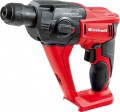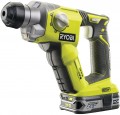Operating modes
— Drilling with impact. A mode of operation that combines rotation and percussive movement of the drill. Due to this, a complex effect on the treated surface is provided; in this case, the impact gives a direct advancement of the drill, and rotation is used primarily to remove the resulting waste. It is this format of work that allows you to effectively make holes in materials like concrete, brick, natural stone, etc .; at the same time, rotary hammers cope with such tasks much more efficiently than the so-called impact drills (drills supplemented with a chiseling function).
—
Drilling (without impact). Traditional drilling, when the hammer works like a drill: the working equipment only rotates, not moving back and forth. It is applied to work with rather soft materials, such as a tree and metal. At the same time, rotary hammers are often more efficient than traditional drills — due to the greater power and weight of the tool, they allow you to drill larger and deeper holes with sufficient accuracy.
—
Chiseling (demolition hammer). In this mode, the punch tool only moves back and forth, without rotation. This format of work can be useful when splitting large pieces of hard material, removing various coatings, etc. We emphasize that a rotary hammer, even a powerful and heavy one, will not replace a full-fledged demolition hammer; however, for relatively simple tasks — such as dismantling smal
...l structures made of relatively soft materials, splitting tiles, chasing walls, etc. — a tool with this mode is quite suitable.Impact energy
The energy transmitted by the perforator to the material being processed upon impact; the higher this indicator, the stronger and more powerful each individual blow.
First of all, we recall that the energy of impacts is directly related to their frequency: an increase in frequency leads to a decrease in energy. Therefore, for models where the number of strokes can be adjusted, this paragraph usually gives the maximum energy achieved at the minimum speed of operation.
In general, higher impact energy improves efficiency when working with hard, stubborn materials, but requires more motor power (especially if it has to be combined with a high frequency). Therefore, it is worth choosing according to this parameter, taking into account specific tasks. So, for occasional use in everyday life, an energy of 2 J or less is enough, for home repair work of medium intensity, at least 3 J is desirable; a power of
4 J or more is already considered high; and in some industrial-grade perforators, this figure can reach 30 J.
Number of thrusts
The number of beats per minute provided by the punch. For models in which the beat frequency can be adjusted, this item indicates the entire adjustment range, for example "1600 — 3000".
High impact frequency, on the one hand, increases the productivity of the tool and can significantly reduce the time required for work. On the other hand, with the same engine power, an increase in the number of strokes per minute leads to a decrease in the energy of each stroke. Therefore, among heavy performant devices, a low frequency is often found — up to 2500 beats / min and even lower. And the ability to adjust the frequency of impacts allows you to adjust the hammer to the specific situation, depending on what is more important — productivity or the ability to cope with hard, stubborn material. For example, for old crumbling brickwork, you can set the speed higher, and for working with stone or dense concrete, it is better to reduce the frequency of impacts by directing engine power to increase the energy of each impact.
Summing up, we can say this: when choosing a perforator, you should focus on both the number of strokes and the impact energy. Detailed recommendations on this subject for specific situations can be found in special sources.
Rotation speed
The speed of rotation of the working equipment provided by the rotary hammer. Usually, this indicates the speed at idle, without load; rated load speeds can be further specified in the characteristics (see below), but this is rare, and this parameter is still considered the main characteristic. It is also worth mentioning that in the presence of a speed controller (see "Functions"), the maximum speed value is given here.
When working in the main mode — drilling with impact — the rotation of the equipment is used mainly to remove waste from the hole, and the revolutions here are of no fundamental importance (they can be very low). Therefore, it is worth paying attention to this indicator mainly in cases where the rotary hammer is planned to be often used for conventional drilling, without impact. And here it is worth proceeding from the fact that
high speeds increase productivity and contribute to accuracy when working with some materials, but reduce torque (compared to tools with the same engine power). So for heavy work with hard, stubborn materials, relatively "slow" tools are usually better suited.
Note also that drilling is not the main task of rotary hammers; therefore, their rotation speeds are noticeably lower than those of the same
drills. On the other hand, in this case, low speeds are often compensated by powerful engines and high torque, which makes it possible to effectively drill holes
...of a fairly large diameter, including using crowns.Max. torque
The maximum torque developed by the rotary hammer.
Without going into too much detail, torque can be described as the working force of a tool. For drilling with impact, this indicator is not of fundamental importance — we recall that the rotation of the nozzle in this mode performs an auxiliary function, and the key parameters are the frequency and energy of impacts. But with traditional drilling, without impact, the torque directly determines the effectiveness of the tool. The higher it is, the more powerful the impact on the material being processed, and the larger the drilling diameter this model can provide. However tools with similar drilling diameter limits may differ in torque; in such cases, you should assume that more operating force requires a more powerful motor and affects the cost, but it contributes to reliability and provides additional guarantee in case of some abnormal situations.
Motor location
The location of the hammer motor is indicated relative to its standard operating position — when the drill is directed horizontally.
— Horizontal. Also, this arrangement can be called longitudinal, because. the engine is placed along the body of the perforator. Due to this, such a tool is more compact than
vertical motor devices. On the other hand,
horizontal motors are subjected to more severe loads, which makes it difficult to use this arrangement in high power rock drills. As a result, tools of this type have relatively low power and productivity, most of them are designed for relatively simple work.
— Vertical. The vertical arrangement assumes placement of the engine perpendicular to a working nozzle. This significantly affects the dimensions of the unit. On the other hand, vertical rock drills use gearboxes that reduce the load on the engine, which makes it possible to create powerful performant tools. Therefore, most professional-level models designed for intensive use in difficult conditions use a vertical engine layout. But also the predominant part of them
without reverse.
Wood drilling max. ⌀
The maximum diameter of a tool that can be used with a rotary hammer when drilling in wood (and, accordingly, the maximum diameter of the resulting hole). With a large drilling diameter, the loads on the device increase, and some models may simply not be designed for them (despite the technical possibility of installing tools of the appropriate diameter), as a result, it is not worth exceeding the maximum specified diameter, because. this may damage the instrument.
Metal drilling max. ⌀
The maximum tool diameter that can be used with a rotary hammer when drilling in metal. See "Maximum drilling diameter in wood" for details.
Concrete drilling max. ⌀
The maximum tool diameter that can be used with a rotary hammer when drilling in concrete. See "Maximum drilling diameter in wood" for details.

